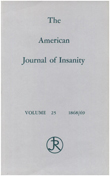Effects of diagnosis, laterality, and gender on brain morphology in schizophrenia
Abstract
OBJECTIVE: Structural neuroimaging and neuropathological studies have demonstrated a variety of aspects of brain morphology that appear to distinguish schizophrenic patients from comparison subjects (diagnostic effects), a predominance of left-sided pathology (laterality effects), and a greater likelihood of brain abnormality among males (gender effects). However, findings have been inconsistent across studies, perhaps reflecting limited power due to small study group sizes. The goal of this study was to examine diagnostic, laterality, and gender effects of brain morphology as assessed by magnetic resonance imaging in a large, carefully evaluated group of schizophrenic and comparison subjects. METHOD: One hundred two patients with schizophrenia (DSM-III- R) (70 men and 32 women) and 87 normal comparison subjects, chosen to be equivalent to the patients in terms of familial socioeconomic background, underwent magnetic resonance imaging with a 1.5-tesla scanner. All regions of interest were outlined manually by an experienced technician on all slices in which they were visualized. Region of interest volumes were compared across groups, and age, sex, and stature were controlled. RESULTS: Schizophrenic patients were found to have larger lateral and third ventricles and smaller thalamic, hippocampal, and superior temporal volumes than comparison subjects. No significant differences were demonstrated for intracranial, cerebral, cerebellar, temporal lobe, caudate nuclei, or temporal horn volumes. There were no significant Laterality by Diagnosis effects and no significant Gender by Diagnosis effects for any of the regions of interest. CONCLUSIONS: Many, but not all, of the hypotheses informed by earlier studies regarding diagnostic effects were confirmed, while hypotheses regarding gender and laterality interactions with diagnosis were not supported.
Access content
To read the fulltext, please use one of the options below to sign in or purchase access.- Personal login
- Institutional Login
- Sign in via OpenAthens
- Register for access
-
Please login/register if you wish to pair your device and check access availability.
Not a subscriber?
PsychiatryOnline subscription options offer access to the DSM-5 library, books, journals, CME, and patient resources. This all-in-one virtual library provides psychiatrists and mental health professionals with key resources for diagnosis, treatment, research, and professional development.
Need more help? PsychiatryOnline Customer Service may be reached by emailing [email protected] or by calling 800-368-5777 (in the U.S.) or 703-907-7322 (outside the U.S.).



